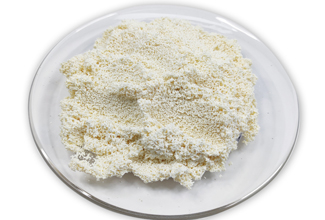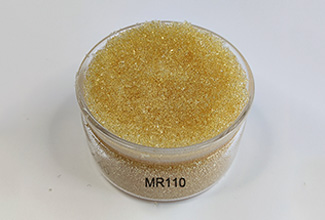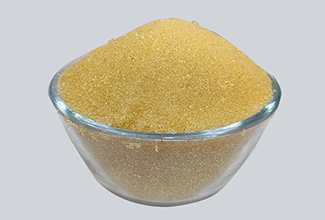Ion Exchange Resins in the Sugar Industry
Sugars or sweeteners are products of plant photosynthesis, which must be separated from accompanying impurities to be of great industrial value to the food manufacturing industry. Usual purification and purification methods can only extract 75- 85% of the sugars from sugar-containing plants. Due to accompanying impurities, 10- 20% of the sugar in molasses cannot be recovered.
Therefore, the ion exchange purification of sugar-containing solutions has become an important topic in the application of ion exchange resins, which is an important method for partial or total recovery of sugar, and its application field has been extended to the whole sugar industry.
Generally speaking, the application principle of ion exchange resin in sugar industry can be divided into: ion exchange, catalysis, chromatographic separation, ion exclusion and adsorption of five categories, each of which can be divided into several subclasses for different purposes.
1. High purification of sugar solution
The use of strong acidic Cation Resin and weak base Anion Exchange Resin, can remove almost all of the non-sugar impurities from the crude sugar solution, to achieve the purpose of almost complete purification. This method of inorganic substances and pigment removal rate is very high, most of them are more than 95%, the removal rate of nitrogen compounds is also more than 70%. The treated sugar solution can be concentrated into high-grade syrup products or boiled refined sugar.
2. Decalcification and softening of sugar solution
Dilute sugar juice in the lime clarification process will increase the calcium content, reducing the purity of the sugar solution, and in the sugar solution evaporation and concentration, causing serious scaling problems. Dilute sugar juice can be treated with a sodium-type cation exchange resin to remove the calcium and magnesium salts in order to reduce the scale build-up in the evaporation tank, which is also known as softening of the sugar juice. If the sugar juice (clear juice or syrup) treated with sodium resin and then treated with strong alkaline resin, the color value of the sugar juice can be reduced by 60-70%, purity improvement, waste honey yield reduction.
3. Decolorization of sugar solution
Decolorization is a key step in the process of syrup refining, ion exchange resin can replace bone charcoal or activated carbon from sucrose, starch sugar, xylose and other refined sugar solution to remove the color value, turbidity and insoluble impurities, and has a high capacity for adsorption, color value, turbidity and insoluble impurities removal ability, can be reused features.
Therefore, the ion exchange purification of sugar-containing solutions has become an important topic in the application of ion exchange resins, which is an important method for partial or total recovery of sugar, and its application field has been extended to the whole sugar industry.
Generally speaking, the application principle of ion exchange resin in sugar industry can be divided into: ion exchange, catalysis, chromatographic separation, ion exclusion and adsorption of five categories, each of which can be divided into several subclasses for different purposes.
1. High purification of sugar solution
The use of strong acidic Cation Resin and weak base Anion Exchange Resin, can remove almost all of the non-sugar impurities from the crude sugar solution, to achieve the purpose of almost complete purification. This method of inorganic substances and pigment removal rate is very high, most of them are more than 95%, the removal rate of nitrogen compounds is also more than 70%. The treated sugar solution can be concentrated into high-grade syrup products or boiled refined sugar.
2. Decalcification and softening of sugar solution
Dilute sugar juice in the lime clarification process will increase the calcium content, reducing the purity of the sugar solution, and in the sugar solution evaporation and concentration, causing serious scaling problems. Dilute sugar juice can be treated with a sodium-type cation exchange resin to remove the calcium and magnesium salts in order to reduce the scale build-up in the evaporation tank, which is also known as softening of the sugar juice. If the sugar juice (clear juice or syrup) treated with sodium resin and then treated with strong alkaline resin, the color value of the sugar juice can be reduced by 60-70%, purity improvement, waste honey yield reduction.
3. Decolorization of sugar solution
Decolorization is a key step in the process of syrup refining, ion exchange resin can replace bone charcoal or activated carbon from sucrose, starch sugar, xylose and other refined sugar solution to remove the color value, turbidity and insoluble impurities, and has a high capacity for adsorption, color value, turbidity and insoluble impurities removal ability, can be reused features.
Last One :
Next Article :
Related Products
-
 Boron Absorbing Resin Macroporous Ion Exchange Chelating ResinAppearance: Creamy to beige opaque beadsIonic form: Free baseVolume complete exchange capacity(mmol/ml): ≥0.80
Boron Absorbing Resin Macroporous Ion Exchange Chelating ResinAppearance: Creamy to beige opaque beadsIonic form: Free baseVolume complete exchange capacity(mmol/ml): ≥0.80 -
 MR110 Mixed Bed Ion Exchange ResinAppearance: Yellow-brown spherical particles.Ionic form:H+/OH-Volume complete exchange capacity(mmol/ml):≥0.6
MR110 Mixed Bed Ion Exchange ResinAppearance: Yellow-brown spherical particles.Ionic form:H+/OH-Volume complete exchange capacity(mmol/ml):≥0.6 -
 001X8 water softener ion exchange ResinIonic form:Na+Appearance: Claybank to tan transparent spherical particle.The degree of crosslinking : 8%.
001X8 water softener ion exchange ResinIonic form:Na+Appearance: Claybank to tan transparent spherical particle.The degree of crosslinking : 8%.
Message

